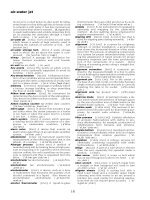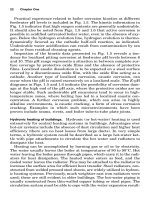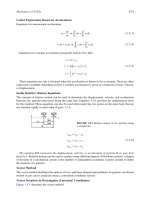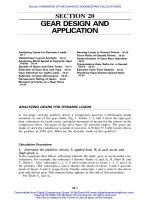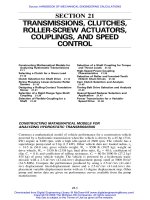Engineering Companion P2
Bạn đang xem bản rút gọn của tài liệu. Xem và tải ngay bản đầy đủ của tài liệu tại đây (141.72 KB, 10 trang )
CHAPTER TWO
2.6
TABLE 2.3
Solubility of Inorganic Substances in Water
(Number of grams of the anhydrous substance soluble in 1000 g of water. The common
name of the substance is given in parentheses.)
Temperature,
Њ
F(
Њ
C)
Composition 32 (0) 122 (50) 212 (100)
Aluminum sulfate Al
2
(SO
4
)
3
313 521 891
Aluminum potassium sulfate
(potassium alum)
Al
2
K
2
(SO
4
)
4
⅐
24H
2
O30 170 1540
Ammonium bicarbonate NH
4
HCO
3
119
Ammonium chloride (sal
ammoniac)
NH
4
Cl 297 504 760
Ammonium nitrate NH
4
NO
3
1183 3440 8710
Ammonium sulfate (NH
4
)
2
SO
4
706 847 1033
Barium chloride BaCl
2
⅐
2H
2
O 317 436 587
Barium nitrate Ba(NO
3
)
2
50 172 345
Calcium carbonate (calcite) CaCO
3
0.018* 0.88
Calcium chloride CaCl
2
594 1576
Calcium hydroxide
(hydrated lime)
Ca(OH)
2
1.77 0.67
Calcium nitrate Ca(NO
3
)
2
⅐
4H
2
O 931 3561 3626
Calcium sulfate (gypsum) CaSO
4
⅐
2H
2
O 1.76 2.06 1.69
Copper sulfate (blue vitriol) CuSO
4
⅐
5H
2
O 140 334 753
Ferrous chloride FeCl
2
⅐
4H
2
O 644§ 820 1060
Ferrous hydroxide Fe(OH)
2
0.0067‡
Ferrous sulfate (green vitriol
or copperas)
FeSO
4
⅐
7H
2
O 156 482
Ferric chloride FeCl
3
730 3160 5369
Lead chloride PbCl
2
6.73 16.7 33.3
Lead nitrate Pb(NO
3
)
2
403 1255
Lead sulfate PbSO
4
0.042†
Magnesium carbonate MgCO
3
0.13‡
Magnesium chloride MgCl
2
⅐
6H
2
O 524 723
Magnesium hydroxide (milk
of magnesia)
Mg(OH)
2
0.009‡
Magnesium nitrate Mg(NO
3
)
2
⅐
6H
2
O 665 903
Magnesium sulfate (Epsom
salts)
MgSO
4
⅐
7H
2
O 269 500 710
Potassium carbonate (pot-
ash)
K
2
CO
3
893 1216 1562
Potassium chloride KCl 284 435 566
Potassium hydroxide (caus-
tic potash)
KOH 971 1414 1773
Potassium nitrate (saltpeter
or niter)
KNO
3
131 851 2477
Potassium sulfate K
2
SO
4
74 165 241
Sodium bicarbonate (baking
soda)
NaHCO
3
69 145
Sodium carbonate (sal soda
or soda ash)
NaCO
3
⅐
10H
2
O 204 475 452
Sodium chloride (common
salt)
NaCl 357 366 392
GENERAL PROPERTIES OF MATERIALS
2.7
TABLE 2.3
Solubility of Inorganic Substances in Water (Continued )
(Number of grams of the anhydrous substance soluble in 1000 g of water. The common
name of the substance is given in parentheses.)
Temperature,
Њ
F(
Њ
C)
Composition 32 (0) 122 (50) 212 (100)
Sodium hydroxide (caustic
soda)
NaOH 420 1448 3388
Sodium nitrate (Chile salt-
peter)
NaNO
3
733 1148 1755
Sodium sulfate (Glauber
salts)
Na
2
SO
4
⅐
10H
2
O49 466 422
Zinc chloride ZnCl
2
2044 4702 6147
Zinc nitrate Zn(NO
3
)
2
⅐
6H
2
O 947
Zinc sulfate ZnSO
4
⅐
7H
2
O 419 768 807
*59
Њ
F (l5
Њ
C).
§50
Њ
F (10
Њ
C).
‡In cold water.
†68
Њ
F (20
Њ
C).
Source: From Avallonc and Baumeister.
1
TABLE 2.4
Solubility of Gases in Water
(By volume, at atmospheric pressure)
t,
Њ
F(
Њ
C) 32 (0) 68 (20) 212 (100)
Air 0.032 0.020 0.012
Acetylene 1.89 1.12
Ammonia 1250 700
Carbon dioxide 1.87 0.96 0.26
Carbon monoxide 0.039 0.025
Chlorine 5.0 2.5 0.00
Hydrogen 0.023 0.020 0.018
Hydrogen sulfide 5.0 2.8 0.87
Hydrochloric acid 560 480
Nitrogen 0.026 0.017 0.0105
Oxygen 0.053 0.034 0.0185
Sulfuric acid 87 43
Source: From Avallone and Baumeister.
1
Thermal diffusivity (
␣
)
Dynamic viscosity (
)
Kinematic viscosity (
)
Surface tension (
)
Coefficient of thermal expansion (

)
The kinematic viscosity of a fluid is its dynamic viscosity divided by its density,
or
ϭ
/
. Its units are m
2
/s. The surface tension of a fluid is the work done in
2.8
TABLE 2.5
Properties of Metallic Solids
Properties at 20
Њ
C
Thermal conductivity,
k
(W /m
⅐
K)
Metal
(kg /m
3
)
c
p
(J/kg
⅐
K)
k
(W /m
⅐
K)
␣
(10
Ϫ
6
m
2
/s)
Ϫ
170
Њ
C
Ϫ
100
Њ
C0
Њ
C 100
Њ
C 200
Њ
C 300
Њ
C 400
Њ
C 600
Њ
C 800
Њ
C1000
Њ
C
Aluminum
Pure
2,707 905 237 9.61 302 242 236
240 238 234 228 215
ϳ
95
(liq)
99% pure
211
220 206 209
Duralumin
(
ϳ
4% Cu)
2,787 883 164 6.66
126 164 182 194
Chromium
7,190 453 90 2.77 158 120 95
88 85 82 77 69 64 62
Copper and Cu alloys
Pure
8,954 384 398 11.57 483 420 401
391 389 384 378 366 352 336
Bass
(30% Zn)
8,522 385 109 3.32 73 89
106 133 143 146 147
Bronze
(25% Sn)
8,666 343 26 0.86 (Data on this and
other bronzes vary by a factor of about 2)
Constantan
(40% Ni)
8,922 410 22 0.61 17 19
22 26 35
German silver
(15% Ni, 22% Zn) 8,618 394 25 0.73
18 19 24 31 40 45 48
Gold
19,320 129 315 12.64
318 309
Ferrous metals
Pure iron
7,897 447 80 2.26 132 98
84 72 63 56 50 39 30 29.5
Cast iron
(0.4% C)
7,272 420 52 1.70
Steels
(C
Ͻ
1.5%)
0.5% carbon
(mild)
7,833 465 54 1.47
55 52 48 45 42 35 31 29
1.0% carbon 7,801 473 43 1.17
43 43 42 40 36 33 29 28
1.5% carbon 7,753 486 36 0.97
36 36 36 35 33 31 28 28
2.9
Stainless steel, type:
304
8,000 400 13.8 0.4
15 17 19 21 25
316
8,000 460 13.5 0.37
12
15 16 17 19 21 24 26
347
8,000 420 15 0.44
13
16 18 19 20 23 26 28
410
7,700 460 25 0.7
25 26 27 27 28
414
7,700 460 25 0.7
29 29
Lead
11,373 130 35 2.34 40 37
36 34 33 31 17
(liq.)
20
(liq.)
Magnesium
1,746 1023 156 8.76 17 16 157
154 152 150 148
90
(liq.)
Mercury
(polycrystalline)
32 30 7.8
(liq.)
Nickel
Pure
8,906 445 91 2.30 156 114 94
83 74 67 64 69 73 78
Nichrome
(24% Fe, 16% Cr) 8,250 448
0.34
13
Nichrome V
(20% Cr)
8,410 466 13 0.33
12 14 15 17 19
Platinum
21,450 133 71 2.50 78 73
72 72 72 73 74 77 80 84
Silver
99.99% pure 10,524 236 427 17.19
449 431 428 422 417 409 401 386 370
176
(liq.)
99.9% pure 10,524 236 411 16.55
422 405 373 367 364
Tin (polycrystalline) 7,304
ϳ
220 67 4.17 85 76 68 63
Titanium
(polycrystalline) 4,540 523 22 0.93
31 26 22 21 20 20 19 21 21
22
Tunsten
19,350 133 178 6.92 235 223 182
166 153 141 134 125 122 114
Uranium
18,700 116 28 1.29 22 24
27 29 31 33 36 41 46
Zinc
7,144 388 121 4.37 124 122 122
117 110 106 100 60
(liq.)
Source:
From Lienhard.
2
Portions of the original table have been omitted where not rele
vant to this chapter.
The data can also be found in Refs. 1, 2, and 4 through 9.
CHAPTER TWO
2.10
extending the surface of a liquid one unit of area or work per unit area. Its units
are N/m. Also, note that
␣
ϭ
k/
c and
1
Ѩ

ϭϪ ϭ
const
ͩͪ
p
Ѩ
t
In general, all thermophysical properties are strong functions of temperature.
Table 2.5 shows properties of metallic solids. Table 2.6 shows properties of
nonmetallic solids. Table 2.7 shows properties of saturated liquids. (Note that the
Prandtl number Pr
ϭ
/
␣
.) Table 2.8 shows properties of gases at atmospheric
pressure. Table 2.9 shows data of surface tension of various liquids. Approximate
relations for thermal expansions are given in Table 2.14.
MECHANICAL PROPERTIES
Mechanical properties commonly used by engineers are
Ultimate tensile strength
Tensile yield strength
Elongation
Modulus of elasticity
Compressive strength
Shear strength
Endurance limit
Ultimate tensile strength is defined as the maximum load per unit of original
cross-sectional area sustained by a material during a tension test. It is also called
ultimate strength.
Tensile yield strength is defined as the stress corresponding to some permanent
deformation from the modulus slope, e.g., 0.2 percent offset in the case of heat-
treated alloy steels.
Elongation is defined as the amount of permanent extension in a ruptured tensile
test specimen; it is usually expressed as a percentage of the original gage length.
Elongation is usually taken as a measure of ductility.
Modulus of elasticity is the property of a material which indicates its rigidity.
This property is the ratio of stress to strain within the elastic range.
On a stress-strain diagram, the modulus of elasticity is usually represented by
the straight portion of the curve when the stress is directly proportional to the strain.
The steeper the curve, the higher the modulus of elasticity and the stiffer the ma-
terial.
Compressive strength is defined as the maximum compressive stress that a ma-
terial is capable of developing based on the original cross-sectional area. The gen-
eral design practice is to assume the compressive strength of a steel is equal to its
tensile strength, although it is actually somewhat greater.
Shear strength is defined as the stress required to produce fracture in the plane
of cross section, the conditions of loading being such that the directions of force
and of resistance are parallel and opposite although their paths are offset a specified
minimum amount. The ultimate shear strength is generally assumed to be three-
fourths the material’s ultimate tensile strength.
